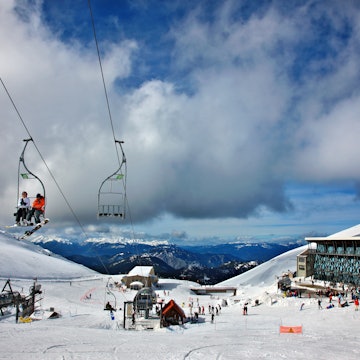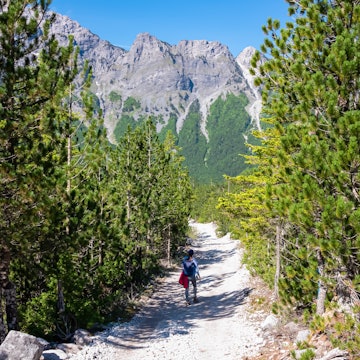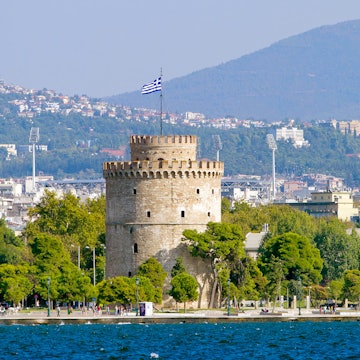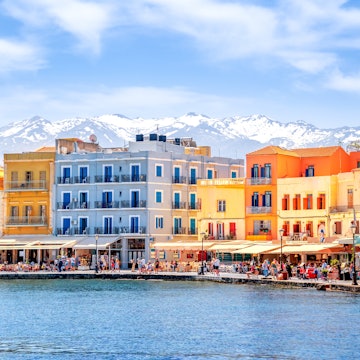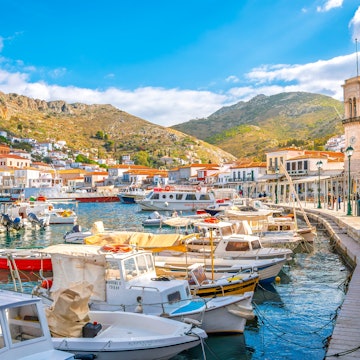

The promenade in Thessaloniki. Aivita Arika/Shutterstock
Hidden beaches, shimmering lakes, villages stuck in time, lofty peaks and cities with pulsing creative energy – welcome to Greece’s least visited and arguably most magical region.
Northern Greece is the mythical home of the ancient Greek gods where you can go swimming in waterfalls, hike through the world's deepest gorge and raft in one of Greece's most beautiful rivers. In the peninsula Halkidiki, you can sunbathe on beaches and snorkel among artifacts in crystal-clear water. In the western lakeside city of Ioannina, you can spend two or three days soaking up the city’s incredible history at its many historic sites and museums, including the Ali Pasha Museum. In the evenings, get lost in melodic clarino music at one of the many tsipouradika traditional taverns serving tsipouro.
Here are some of the best things to do in Northern Greece at any time of year.

1. Discover world-class history at Vergina Royal Tombs
The hero of northern Greece is undoubtedly Alexander the Great, son of Philip II (382–336 BCE) and king of ancient Macedon (336–323 BCE). He was the military leader who in a few short years managed to conquer huge swath of land across Europe and Asia, thus putting Greece on the map. One of the enduring archaeological mysteries of our time is where, exactly, this illustrious ruler was buried. Perhaps that’s why the tombs of Vergina are so important.
This UNESCO World Heritage Site and its museum are truly impressive: sprawling out for kilometers are the Palace of Philip II (the biggest and most elaborate remaining building of Classical Greece), the theater where Philip was assassinated, the sanctuaries of Eukleia and the Mother of the Gods, the city walls and the royal necropolis containing more than 500 tumuli (burial mounds), including 12 oversize, temple-shaped tombs. Most of these tombs were pillaged, which makes Philip’s tomb – which was uncovered in 1977, completely unspoilt – all the more impressive.

2. Soak in thermal waters in Pozar
Near the border with Bulgaria, there’s a network of hot springs, natural pools and rivers, all with thermal water naturally heated to 37°C. Thermal waters have long been used in Greece as medical treatments for weary bodies; this particular spa has been in use since the 1960s and is a soothing way to relieve tension. In addition to bathing alfresco, you can choose from 48 individual, indoor baths. It’s a particularly stunning experience at night, under the stars and full moon.
Planning tip: Located 105km northwest of Thessaloniki, it’s possible to visit Pozar for the day, but for ultimate relaxation, consider spending the night.
3. Follow a philosopher's footsteps to Aristotle's birthplace
Aristotle, one of the Western world’s greatest philosophers, was born in Halkidiki, in the ancient city of Stagira, in 384 BCE. The famed philosopher was best known for founding the Peripatetic school of philosophy at the Lyceum in Athens and laying the basis for modern science. He left Stagira when he was a teenager and returned to northern Greece when he was in his late thirties. The city was completely occupied and destroyed by Philip II of Macedon, Alexander the Great’s father, in 348 BCE. Philip later rebuilt the city in exchange for Aristotle tutoring his son Alexander. Perched at an elevation of 500m, the sprawling ruins (the fortified city walls and remains of a citadel are still on display) have a lovely view of the sea and are often free of tourists, giving you ample space to imagine life as it was in ancient Greece.
Planning tip: There’s a 17km walk you can do that starts at Aristotle’s Park, a modern complex with tactile instruments, including a compass and a sundial, which demonstrate basic natural laws as described in Aristotle’s book Physics. Continuing onward, you’ll eventually reach Ancient Stagira; the walk will take about six hours. The sites can also be visited by car.
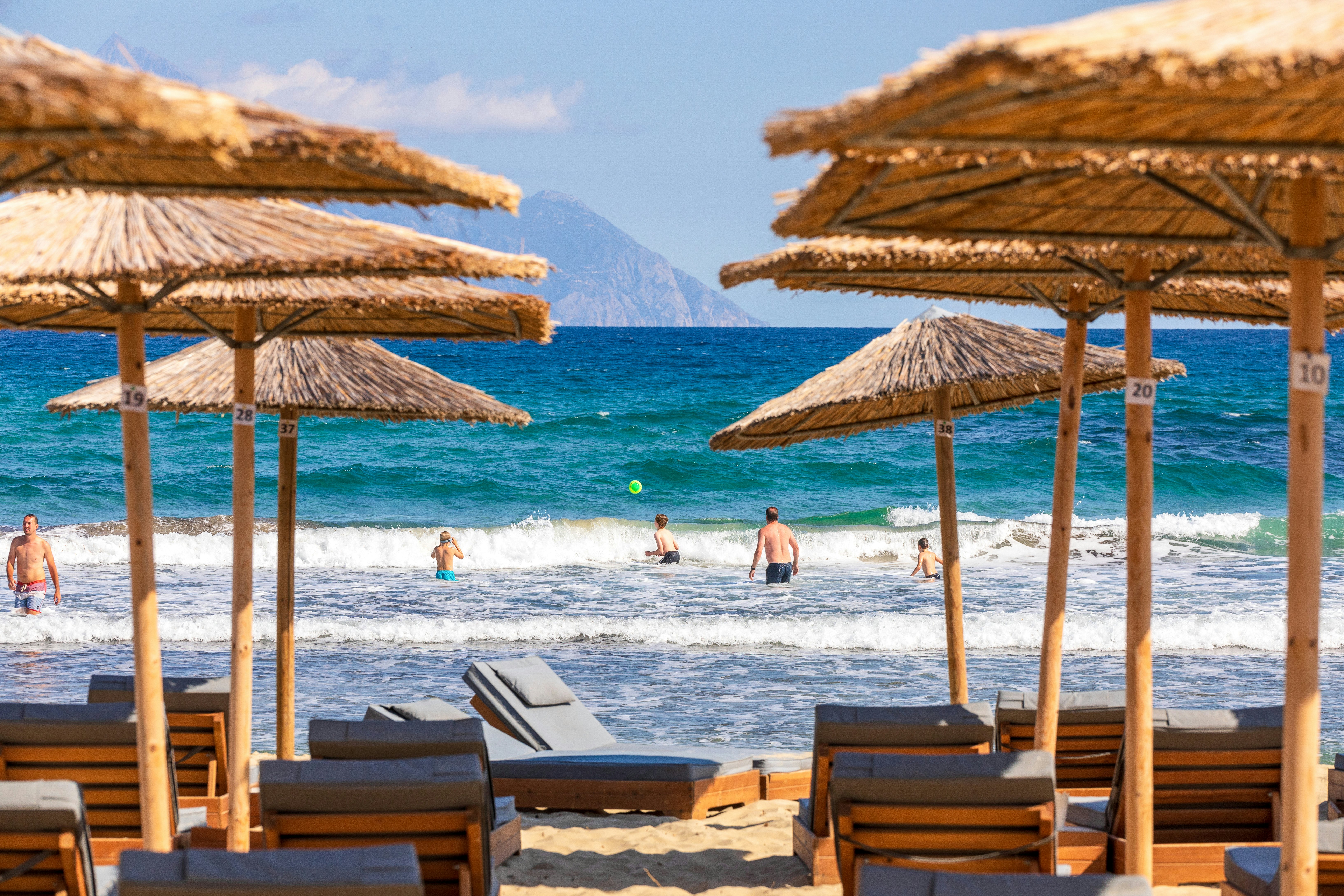
4. Enjoy sun, sea and surf in Halkidiki
Halkidiki’s beaches are beloved for a good reason – there’s 500km of coastline to explore and the area has more sandy spots than most islands. When heading out, first decide if you want an organized beach (with sun loungers, bars, canteens, toilets and changing rooms, and usually loud music) or unorganized (you’ll have to bring all your own gear). Kassandra, the first leg, is almost exclusively organized beaches; things get a bit wilder in Sithonia, where you can even find nudist beaches. In Kassandra, Glarokovas is a natural sandy harbor that extends for a long time, making it perfect for big groups. You’ll find fun beach bars and food trucks, and you can go fishing on the rocks. Sani is one of the biggest beaches in Kassandra, with fragrant pine-tree forests that descend onto the Blue Flag white-sand beach.
Planning tip: If you want to go diving, head to Nikiti in Sithonia, where the expert outfit Atlantis Diving Center can arrange diving expeditions for all levels, including dives for first-timers and kids. You’ll get the chance to glimpse scorpion fish, sea bass and a sea floor fluttering with anemones.
5. Visit a female-run winery in Goumenissa
Winemaking remains a male-dominated industry across Europe, and Greece is no exception. That’s part of what makes Domaine Chatzivaritis such an intriguing place. The family-owned business has since been taken over by the Chatzivaritis daughter, Chloi, who trained in France and has been slowly turning the domaine over to natural wines. In addition to cultivating Greek varieties, Domaine Chatzivaritis also makes bottles with well-known, popular grapes like Merlot and Chardonnay. One of the larger wineries in the area, the emphasis is still on organic and natural farming and fermentation.

6. Hike among Greek gods at Mt Olympus
Composed of three summits – Mytikas, Skolio and Stefani – Mt Olympus is Greece’s highest mountain, with 46 peaks exceeding 2000m. It's also the mythical home of the ancient Greek gods. Lush and virgin, it is home to more than 1700 plant species, some rare and endemic, as well as wolves, jackals, deer and more than 100 bird species. It was declared a UNESCO Biosphere Reserve in 1981. The air here is crisp and cool, even in the hottest summer months, and the sweet smell of pine trees, the sound of chirping birds and roaring water, and the way the light filters through the trees all contribute to the otherworldly atmosphere of Olympus. Hiking here – or camping overnight – feels truly mythical.
Mytikas is the highest point of the mountain (2917m), while Zeus’s Throne lies at the top of Stefani (2909m). Rock climbers will have a field day along the northern face of Skolio (2911m). But no matter your hiking level or experience, there’s something for everyone on Olympus. One of the most popular routes is the E4 Prionia Trail, which starts in Litohoro and ends in Mytikas, taking you past the Agios Dionysus Monastery and the Spilios Agapitos Refuge. A full climb of Mt Olympus will take two to three days, with overnight stays in one of the six mountain huts that dot the landscape. The Olympus National Park Information Centre in Litohoro has more information on all the hikes you can do in the area.
Planning tip: The best time to visit Mt Olympus is during late spring and early autumn, when the weather is mild and the crowds still thin. Avoid winter, when most trails are closed due to dangerous weather conditions. Summer offers a respite from the heat, but everyone else has the same idea and trails are crowded.
7. Pay homage to Zeus at Ancient Dion
In the shadows of Mt Olympus lie the ruins of Dion, a verdant sanctuary where the ancient Macedonians used to worship the Olympic gods – in particular Zeus, who was thought to reside on the mountain’s peak. Alexander the Great used to make sacrifices to the gods here before his conquests, and there is still a special energy across the sprawling complex.
You can easily spend a few hours wandering through the ruins: first up is the 6th-century-BCE Sanctuary of Demeter; further along is the leafy Sanctuary of Zeus Hypsistos, which bears copies of statues and column bases. The standout is the Sanctuary to Isis, where a statue of the Egyptian goddess of childbirth stands tall among rustling bamboo. (Note that the Sanctuary is usually flooded, so you won’t be able to walk inside it.) Other constructions, including Christian basilica ruins and public baths paved with mosaics, are also on view.

8. See a feat of architecture at Kalarrites
Near the village of Kalarrites, 65km southeast of Ioannina, you’ll come across the jaw-dropping Kipinas Monastery. Chiseled into the face of the mountain, this 13th-century church is one of the most impressive feats of spiritually inclined architecture in the country. The monastery’s history is as storied as its location: it was built using local materials in 1212 by a group of monks who set out to establish a new order after a disagreement with their abbot at the nearby Vyliza Monastery. In the ensuing centuries, bridges and high walls were put up around the church to make it inaccessible to raiding parties; later on, the monastery would serve as a refuge during the Greek revolution.
Planning tip: The church is open to the public, but you’ll find the keys to the monastery in the last tavern in Kalarrites (look out for the “Keys Here” sign).
9. Wild swimming in at the waterfalls of Valvara
Head to the lush eastern interior of Halkidiki for some of the most interesting wild swimming the peninsula has to offer, trading the salty Mediterranean for the cool, crisp natural ponds that form at the base of several hidden waterfalls. Drive out of Olympiada village toward Varvara, through dense foliage that reveals one of the area’s most scenic routes. A 4km hike through forests will lead you to the Varvara waterfalls, where you’ll feel like a fairy for the day.

10. Go river rafting on one of the most beautiful rivers in Greece
The meandering Arachtos River is one of the most beautiful in Greece. Though it starts above Ioannina, near Metsovo, by the time it reaches Tzoumerka it’s nearly empty of people. That makes it a particularly worthwhile spot to try rafting. There’s a 10km rafting route that begins at the Politsa bridge (which connects the village of Ampelochori with Fortossi); don a lifejacket and head out with one of several local outfitters.
One of the most reputable is Trekking Hellas, which organizes multiple rafting trips throughout the day. As you raft down Arachtos, you’ll come across gravity-defying stone bridges that curve gracefully towards the sky. The best known is Plaka; it was originally built in the 19th century as a single stone arch crossing the Arachtos in a remarkable feat of engineering. It was the largest bridge in the Balkans, and the third-largest in Europe – and unsurprisingly was a source of pride for locals. A storm destroyed the bridge in 2015, but it was fully restored in 2020.
11. View mysterious rock formations in Greece's largest cave
Perama is Greece’s largest and most impressive cave, spanning some 15,000 sq meters, on the northern side of Lake Pamvotida in Ioannina. The cave has a storied past. It was discovered by accident in 1940 by residents fleeing German bomb attacks, and a husband-and-wife team properly began spelunking in the 1950s.
Tours through the damp passageways run by the hour, and they last around 45 minutes. You can’t access the caves without a guide, but this is for the best as the knowledgeable guides here share many fascinating facts about geology and unique cave fauna. You’ll learn about the 19 different types of stalactites and stalagmites, plus the underground lakes and the spelunkists who found fossils of animal teeth and bones (including those of the cave bear, a very rare animal that was discovered here).
Planning tip: Bring a jacket, even in summer, as the cave is notoriously chilly. Keep your eyes peeled for the “Church,” a mysterious rock formation that looks exactly like a cross.

12 . Ski and eat delectable grilled meat in Metsovo
You’ll likely smell Metsovo before you see it – a heady mix of pine trees, grilled meat and burning wood. Next, you’ll see the white plumes of smoke gracefully rising above the red-tiled roofs, disappearing into the dense, verdant forest. Metsovo is a year-round destination that inspires nostalgic delight in most Greeks and an increasing number of foreign visitors.
It’s a singular village, thriving on tourism but still naturally charming, full of friendly people and tasty food, and bursting with alpine-perfect scenery. The local delicacy is kokoretsi (lamb liver wrapped in intestines); those with less adventurous palates should try provatina (female sheep). Skiing is a draw in winter (the largest center is Metsovo Ski Centre); in summer, the hiking is good; and year-round it’s a pretty place to stop for a night or two and take in the distinct culture, bounteous cheeses and interesting history.
Planning tip: For excellent grilled meat (don’t miss the provotina or kokoretsi), local cheese and a nice patio, try the restaurant at Grand Forest Mestovo.
13. Stock up on treats in the antique shops and food markets of Thessaloniki
Thessalonikians are known for their love of shopping, but there are much more interesting places to buy things than the high street. Head to Tositsa Street, where you’ll find an amazing jumble of antique shops, selling everything from communist belt buckles to Ottoman-era tchotchkes. There are records, jewelry, furniture, books, military uniforms and much more. Food lovers should make a beeline for the Kapani Market. Located in the city center, this is the place to stock up on Greek products like mountain tea, mastic from Chios and pine-tree honey. In addition to non-perishables, you can stroll through the fresh fish and meat sections of the market. Be sure to grab lunch at Stou Mitsou, a tsipouradkia selling delicious grilled and fried dishes between the market stalls.

14. Step back in time at Its Kale
Ioannina’s fortified old castle district (called Its Kale) hosts the bulk of the city’s most impressive historic sites. You’ll immediately notice the Fethiye Mosque, which still has its impressive sky-high minaret. The mosque was the first one built by the Ottomans in the 15th century (its name translates to “mosque of conquest”), and it was later elaborated on by Ali Pasha – who, incidentally, is buried right next to it in a wrought-iron sculptural tomb that resembles a bird cage. The Aslan Pasha Mosque, which also includes a Turkish hammam and madrassa, is in the same area.
Don’t miss the Silversmithing Museum. Built into the wall of the citadel, this multistory exhibition space provides a fine overview of the importance of silverwork in Ottoman-era Ioannina. The top floor, with its many silver objects suspended on clear thread, is particularly interesting. The Municipal Ethnographic Museum housed in the Aslan Pasha Mosque also worth a visit; the local costumes and objects are particularly fascinating. The whole area was recently made wheelchair-accessible.
15. Take a boat ride to car-free Ali Pasha's island
In the middle of the lake of Ioannina, the reed-encircled patch of land that locals call To Nisi (simply “the Island”; there’s no official name) is a pretty, peaceful destination for sightseeing, a boat ride or a stroll on car-free streets. Small boats leave frequently from the lakeside of Plateia Mavili (Mavili Sq), the ride taking about 10 minutes.
The island is most famous for being the summer home of Ali Pasha, the formidable Albanian ruler who married a Christian woman and was well known for his political savviness, thus managing to rule Ioannina as a de facto independent city. His residence has since been turned into the Ali Pasha Museum, a charming little museum run by a former baker who began collecting Ali Pasha memorabilia some decades ago and opened it in 2012. You can spend about an hour poring over the lovingly curated exhibits and objects (including a meter-long pipe that was the Pasha’s favourite). Look out for the bullets in the floorboards; Ali Pasha was famously murdered here by the Ottomans.

16. Roll in the deep at the world's ‘deepest’ gorge
The star of the village of Zagoria is the Vikos Gorge, a 12km-long, 900m-deep valley carved over millions of years by the Voïdomatis (“Good Water” in its Slavic root) River. It’s often referred to as the world’s deepest gorge, and this is only a slight misnomer – according to the Guinness Book of World Records, it’s the world’s deepest canyon in proportion to its width. The O3 hiking routes around and in the gorge are mostly well tended and marked. The most typical, if quite challenging, route starts in Monodendri, where a steep path heads down. At the canyon’s end, a right-hand trail leads to Mikro Papingo; the walk takes more than six hours.
Planning tip: The only water is at Klima Spring, halfway along the gorge. It’s a good idea to come well-prepared with snacks and water.








